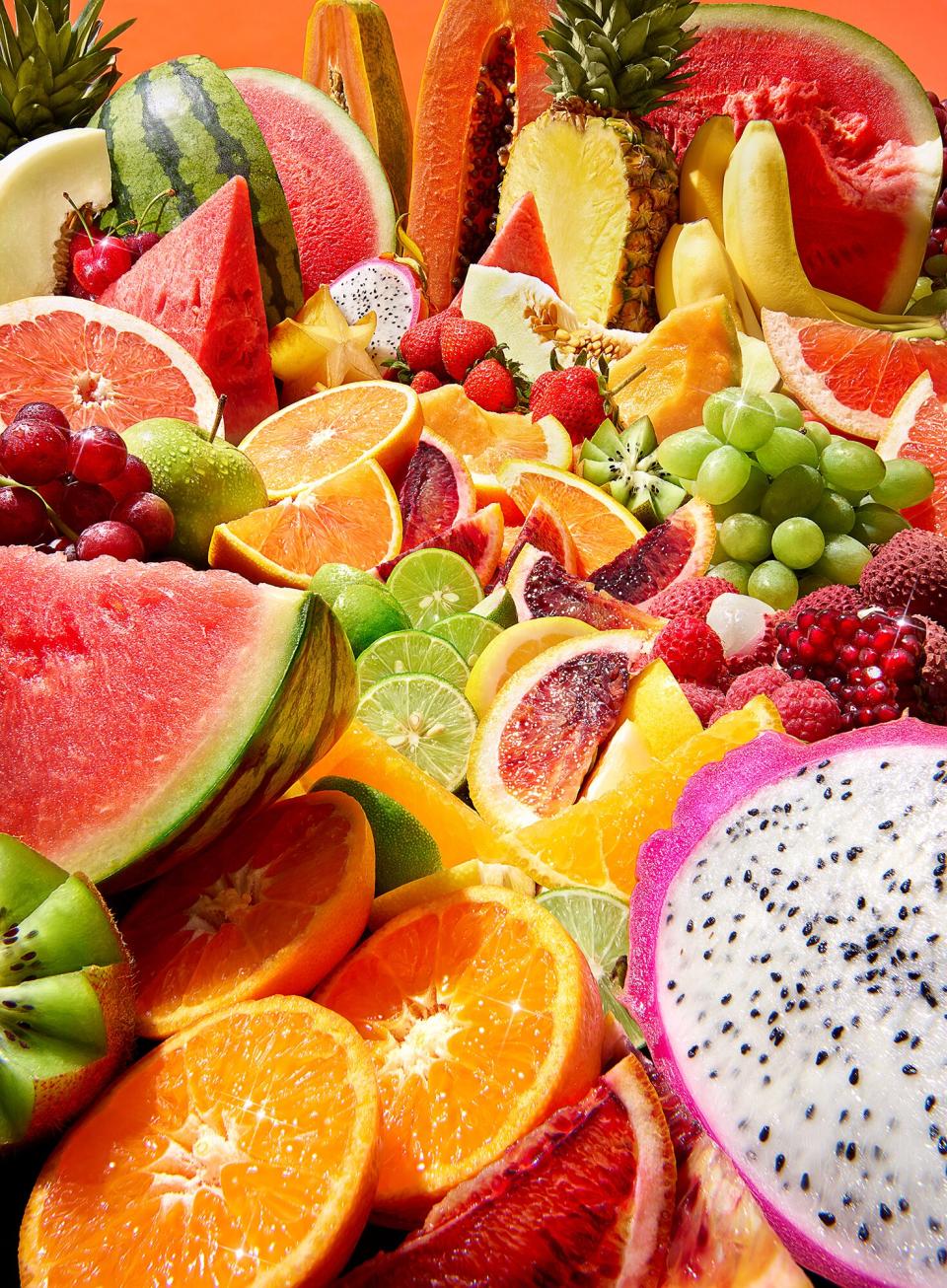What's the Big Deal About Sugar? We Have Your Questions Answered
Human beings are primed to seek sweetness. To our ancient ancestors, a sugary taste meant safe, calorie-dense food that their bodies could store as fat for later on—when the honey was gone and fruit was out of season. (Bitter flavors, by contrast, indicated that a plant might be poisonous, and sour ones signaled precious calories had spoiled.) Throughout evolution, our taste buds have been our foodie guide, ushering us toward healthy calories and away from things that could be dangerous (for more on that, check out what happens to your body when you eat too much sugar).
But sweet, plentiful calories are no longer rare, and our taste buds' helpful direction has become outdated. Added sugar has snuck into all sorts of sweet and savory foods, from sandwich bread to frozen dinners. And we're eating a whole lot of it. Americans currently get 13% of their total daily calories from ingredients like table sugar, high-fructose corn syrup, honey and other added sweeteners. That's about 17 teaspoons worth, or 68 grams. (Natural sugars found in fruits, vegetables and dairy products are not considered added. Plus, these foods come with other nutrients that make them healthy.) The Dietary Guidelines for Americans recommend that we limit consumption of added sugars to less than 10% of the calories we eat each day, or about 12 teaspoons (48 grams) for a 2,000-calorie diet. But many experts say we should probably get even less to reduce our risk for health conditions linked to excess sugar consumption, such as obesity, type 2 diabetes, cardiovascular disease and cavities.
Our problematic sweet tooths have made sugar something of a nutritional pariah. A 2021 International Food Information Council poll of more than 1,000 Americans found that 72% of adults are trying to limit or avoid added sugars in their diets. And according to the research group NPD, the first piece of information people look at on the Nutrition Facts panel is sugar, followed by calories.

What's the Big Deal About Sugar?
That panel could indeed be a useful tool in helping people cut back. Starting this year, the Nutrition Facts must specify how many grams of the total sugars in a product are added sugars, as well as the percent Daily Value of calories they account for. Prior to this it was impossible to tell if the sugars in a food or beverage were added or the naturally occurring type, since only total sugars were listed. (Natural sugars + added sugars = total sugars.)
This one line will make a huge dent in chronic conditions like heart disease and diabetes, says Renata Micha, RD, Ph.D., an associate professor of human nutrition at the University of Thessaly in Greece. According to research she conducted at Tufts University on the link between added sugar intake, body mass index and various health outcomes, an estimated 354,400 cases of cardiovascular disease and 599,300 cases of type 2 diabetes could be prevented between 2018 and 2037 in the U.S. alone by providing added sugar information to consumers.
Disclosing this info could also result in an estimated net savings of $31 billion in health care costs over the same period. The reason: people will read labels and choose lower-sugar options; and if demand prompts food companies to cut the amount of sugar in their products, the reduction in disease and health care costs would be even greater. In fact, many manufacturers have already reformulated their products in anticipation of the new labeling requirements. "It can be a very powerful tool, because it educates the consumer," says Micha. "And food companies need to be able to provide that option to them."
So, if you're among those looking to eat less sweet, you've come to the right place. Consider this your guide to all-things-sugar, including what it does in your body, the health perks of curbing your intake and brilliant little ways to slash it from your diet—and still have your pie too. We'll even share the recipe.

The Voorhes
Sugar Nutrition Facts & Basics
Sugar is a simple carbohydrate, and there are many different types. For example, glucose (a primary component in honey) and fructose (found in fruits and root veggies) are mono saccharides, which can't be broken down into smaller sugar molecules. Lactose (in dairy products) and sucrose (white sugar) are disaccharides, meaning they're composed of two monosaccharides linked together. High fructose corn syrup (added to all sorts of processed foods) is also made of two monosaccharides, fructose and glucose, but they aren't chemically bonded and thus don't need to be broken down during digestion—one reason HFCS may get absorbed into the bloodstream more readily. Many foods contain more than one kind of sugar.
Your body's cells normally run on glucose. When you eat a dessert or another food with sugars in it, enzymes in the digestive process break them apart—sucrose, for instance, becomes glucose and fructose— and the monosaccharides enter your bloodstream. The pancreas senses blood sugar levels rising and releases insulin, signaling your cells to take up that glucose for energy and causing blood sugar levels to drop back down. Frequent shots of glucose into the bloodstream from sugary beverages and foods (particularly ultra-processed ones) make blood sugar levels shoot up quickly and then plummet, which can lead to weight gain, type 2 diabetes and other health issues.
Fructose, on the other hand, is processed mostly in the liver. When this organ receives excess fructose, like from the HFCS in soda, it uses it to make fat that is stored in the liver. In excess, this can cause nonalcoholic fatty liver disease, resulting in inflammation and cirrhosis. Nonalcoholic fatty liver disease affects up to 24% of all adults in the U.S.
But sugars found naturally in whole foods—such as the fructose in fruits or the lactose in milk—enter your bloodstream much more slowly because they move through your system within a so called "food matrix," surrounded by fiber, fat and/or protein. (Same goes for other foods with added sugars, like 100% wholewheat bread.) As a result, you get a flatter blood sugar curve, steadily powering your cells without taxing the body, says Purdue University nutrition researcher and EatingWell advisory board member Richard Mattes, Ph.D., M.P.H., RD. In other words, the protein, fat and fiber in whole foods help blunt the potentially negative effects of natural sugars—and offer perks of their own, such as improving satiety and providing vitamins and antioxidants.
This isn't true of produce based items that lack their food matrix, like 100% fruit juice— in this case, the fiber has been stripped out. While juice does supply vitamins and antioxidants, Mattes says your body will treat its natural sugars the same way it does the added ones in a Big Gulp.
The Debate over the Dietary Guidelines
The Dietary Guidelines for Americans, 2020-2025 upheld the same advice on added sugars as the 2015-2020 edition—and that the World Health Organization gave even earlier. "The World Health Organization recommended added sugars contribute no more than 10% of the calories in your daily diet based on research on the link between sugar and dental caries, and this later became a guideline for weight management as well," says Purdue University's Richard Mattes, who was a member of the Dietary Guidelines Advisory Committee's Beverages and Added Sugars Subcommittee. At the time, tooth decay was the primary health consideration—not other negative outcomes, such as type 2 diabetes.
The Added Sugars Subcommittee was tasked with investigating all the research on added sugars (which did take into account their impact on chronic diseases) and advised limiting added sugars to only 6% of daily calories. Why? For starters, added sugars provide calories but often no nutritional value— important since more than 42% of American adults have obesity. And by the experts' estimates, after a person consumes the nutrients they need from healthy foods, just 15% of daily calories are left over. They then divided these "discretionary calories" between added sugars and solid fats like butter, based on typical American consumption patterns. And voilà: 6% of calories were allotted to added sugars and 9% to solid fats. (No calories got earmarked for alcohol.)
But the United States Department of Agriculture (USDA) and Department of Health and Human Services (DHHS)—which ultimately set the Dietary Guidelines for Americans—decided to stick with the higher 10% number. "There was not a preponderance of evidence in the Committee's review of studies since the 2015-2020 edition to substantiate changes to the quantitative limits," the agencies wrote in a response to the report.
Mattes points out that because there's no physiological need for added sugar, "The members of my committee still believe that 6% is the better target. It sends a stronger message to the public that reducing added sugars would be a healthful decision." The American Heart Association also recommends keeping added sugars to about 6%—or no more than 25 grams a day for women and 36 grams for men. However, because Americans already consume about 13% of daily calories from added sugar (about 68 grams), many experts note that any reduction is important.

The Voorhes
Top Sugar Questions
Is sugar addictive?
Nope. It does trigger your brain's reward system, releasing the pleasure neurotransmitter dopamine and encouraging you to eat. Sugar can also lead to cravings. "But there is an order of magnitude difference in the neurochemical response to sweeteners versus drugs of addiction," says Mattes. "And the evidence in humans is far from compelling." The term "emotional eating" may be a better descriptor of an unhealthy relationship with sugar. Or it could just be habit. "The more somebody eats sugar, the more it becomes part of their daily routine and their brain actually looks forward to having that sweetness," says Laura Andromalos, M.S., RD, clinical nutrition manager at the University of Minnesota Medical Center. "That's the challenge: how do we help people find other ways to find pleasure in food and in life without requiring so much sugar?"
Naturally occurring sugars like maple syrup, honey and agave are better for you than straight sugar, right?
"Basically, sugar is sugar," says the Mayo Clinic's Jason Ewoldt. "At the end of the day, if you have maple syrup or table sugar, it's all going to do the same thing as far as what happens inside your body." (It's that lack of food matrix again.) That said, natural sweeteners offer some additional nutrients—maple syrup, for example, has manganese and riboflavin. "And people might find more pleasure in them be cause they have so much flavor and be able to enjoy smaller portions," says Andromalos.
Can sugar substitutes help you control you weight?
Yes, at least in the short term. "Nonnutritive sweeteners could be a really important steppingstone for people who consume a lot of sugar and are working on ways to cut back," says Andromalos. But the goal, she adds, would be to eventually reduce artificial sweetener intake as well. A 2020 analysis of 20 longer term randomized controlled trials found that among people with overweight or obesity, those who ate nonnutritive sweeteners such as sucralose instead of sugar lost a significant amount of weight without dieting—an average of around 6 pounds. (Other nonnutritive sweeteners include saccharin, monk fruit, acesulfame potassium, neotame, advantame and stevia.) "There are people who believe passionately that low calorie sweeteners are problematic. But the overwhelming preponderance of evidence does not support that view," says Mattes. "The evidence indicates that these sweeteners are relatively neutral, or that they're beneficial. Given that there are so few tools available to people who are trying to moderate energy intake, it was the view of the DGA committee that this should be an option they could explore."
Are sugar-sweetened beverages particularly unhealthy?
Yes. They deliver a large dose of sugar that your body rapidly digests—since there's no fiber or other food matrix to slow the body's absorption of it. And they have no nutritional value. In addition, some studies suggest that these drinks stimulate appetite and spur overeating. And as a liquid, they don't make you feel as full as solid food, so you're less likely to compensate for the calories by skipping something else later, like you might if you had eaten an apple instead of sipped apple juice. But are they really any worse for you than, say, sucking down Skittles? Not really—it's just that a large portion of the research on added sugars is specifically focused on sweetened beverages. Scientists like to study them because they're easy to quantify—people can say, "I drink one energy drink every time I exercise," or "I have one coffee with sugar every morning." It would be harder to precisely tally up the amount of sugar from various foods. In fact, sugar-sweetened beverages are the number one source of sugar in the American diet. On average, 24% of the calories Americans get from added sugars come from items like soda and fruit drinks (not 100% fruit juice). Another 11% comes from coffee and tea that have been sweetened with sugar.

